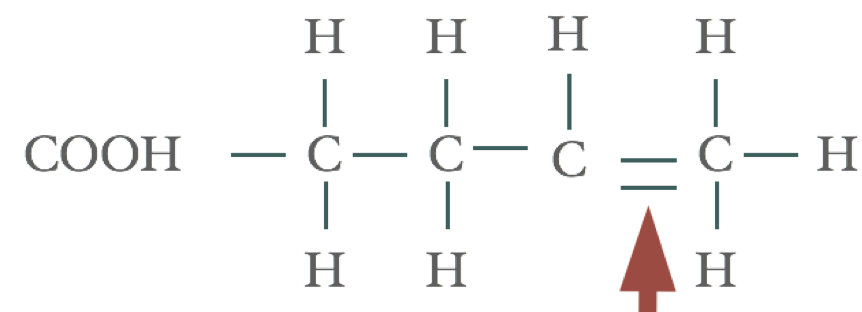Polyunsaturated fats
Polyunsaturated fatty acids (PUFAs) are present in cell membranes throughout the body and an imbalance results in ill health as a result of chronic low-grade inflammation.
Let’s remind ourselves of the biochemistry of the unsaturated fat on our description of fats. I know, this might be the first time you've been introduced to the biochemistry of fats but try to stay with me.
So the carriages in our train are the carbon (C) atoms.
A fatty acid consists of a carbon chain with the COOH end and a Methyl (CH3) end. Saturated fats contain single bonds between the carbon chains. These bonds are strong and stable. Unsaturated fats contain one or more double bonds between the carbon chains. If there is just one double bond in the chain of carbon carriages, the fat is called a monounsaturated fatty acid – with mono meaning one.

Olive oil is 75% monounsaturated. Palm oil is over 40% monounsaturated. If there are more than one double bonds between carbon carriages, the fat is called a polyunsaturated fatty acid. Fish oils and vegetable oils are high in unsaturated fats. Double bonds are inherently weak and easily break when subject to heat, sunlight and chemicals, causing free radicals which cause inflammation in the body. A broken bond also means a ‘rancid’ oil. Many vegetable and seed oils that sit in bottles on our shelves will be readily susceptible to breakage of their double bonds from sunlight and warmth.
Omega 3 oils are typically found in cold water oily fish such as Salmon and Mackerel as well as in cod liver oil. The particular type of omega 3 oil in fish, Eicosapentaenoic acid (EPA) and Docosahexaenoic acid (DHA) have a diverse range of health benefits including for brain development and function, eyes, heart and anti-cancer properties. Walnut and flax seeds are also a rich source of omega 3. However, the type of omega 3 found in these foods, Alpha- Linolenic acid (ALA), is not readily converted to EPA and DHA.
Omega 6 fatty acids are also an essential fatty acid for our body, however, high levels can cause inflammation and is therefore associated with many chronic diseases such as obesity and poor brain function including learning and memory difficulties, CVD, autoimmune disorders, diabetes, arthritis and cancers.
Studies have shown that the optimum omega 6:3 ratio is between 4:1 and 1:1. In my practice it is rare to find anyone below 6:1 unless they have paid careful attention to their diet. The typical Western diet with high sugars and high ‘bad’ saturated fats can result in ratios up to 50:1. Omega 6 and omega 3 compete with one another during metabolism. This means that high omega 6 levels actually promote low omega 3 levels.

Cereals are a major culprit when it comes to inflammation causing foods. Over many hundreds of years our dietary patterns have changed to such an extent that wheat, maize (corn) and rice dominate our food plates. Not only do cereals push up our carbohydrate intake, they also contain omega 6 fatty acids.
Reversing abnormal ratios requires:
- Exercise – this will increase ‘good’ HDL levels
- Diet to reduce processed foods and increase omega 3 levels
- Omega 3 fish oil supplements – sadly many of our sources of fish are contaminated with toxins and heavy metals. The only way to receive high doses of fish oil if these are needed is with supplementation. You can ask supplement manufacturers for third party certification showing that their product has been adequately checked and is safe.
